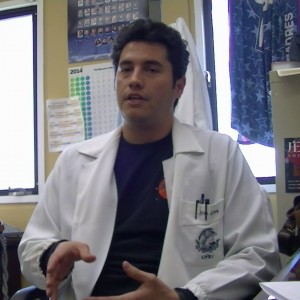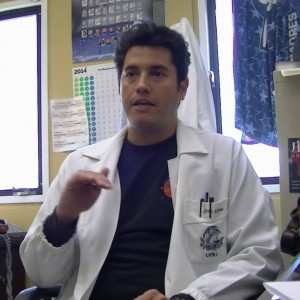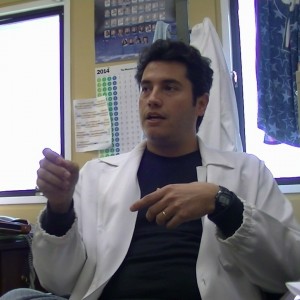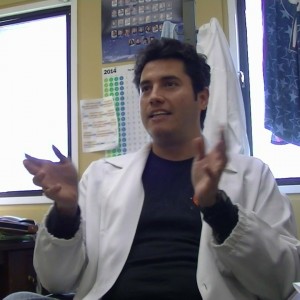今回は、米国カリフォルニア州にあるNASA エイムズ研究所にて放射線耐性能を持つ極限環境微生物について研究をしておられるイヴァン・パウリーノ-リマ先生にお話を伺いました。NASAエイムズ研究所には、世界最大の風洞実験施設や太陽系外惑星の探索を行う部門などだけでなく宇宙生物学の部門もあり、生命の起源や進化についての研究などが行われています。
近年、生理学的要因、特にマンガンの細胞内蓄積と放射線耐性に相関があることが分かってきており、パウリーノ-リマ先生は環境微生物学のアプローチを用いて細胞の放射線耐性に関する研究を進めていらっしゃいます。
※点線がついている単語にカーソルを当てると簡単な日本語訳が見られます
― Ivan thanks for joining us today, we would like to interview you about your research and how metabolomics analysis is contributing to your work.
My research is about radiation resistant microorganisms.
 I’m collecting samples from different environments, like desert environments, because deserts supply a desiccating environment and it is known that desiccation is related to radiation resistance.
I’m collecting samples from different environments, like desert environments, because deserts supply a desiccating environment and it is known that desiccation is related to radiation resistance.
The other factor is manganese; deserts rich in manganese are where I collect a lot of my samples. Manganese has a role in radiation resistance because it can act as an antioxidant inside the cell, and it is already demonstrated that cells that can accumulate high amounts of manganese inside the cell can protect proteins from irradiation.
When you irradiate cell there is an increase in reactive oxygen species, and manganese can scavenge the effects of these reactive oxygen reactions. Based on this information, we think that deserts rich in manganese are a good place to find radiation resistant microorganisms.
There are several ways that organisms survive radiation, there are physiological factors like accumulation of manganese, there are mechanisms of DNA repair that can repair the damage caused by the radiation, and also the production of pigments. Pigments are the main target of my research now, so now in experiments where we look for radiation resistance organisms, I look for pigmented organisms, colonies that grew after high doses of UV-C radiation then I isolated the different organisms.
― So which different sample sites have you been to so far?
 So far I have been to the Sonora Desert here in the US in Arizona. I have also been to the Atacama Desert, which is the driest place on earth; it is considered a Mars analog because the dry conditions and high radiation levels.
So far I have been to the Sonora Desert here in the US in Arizona. I have also been to the Atacama Desert, which is the driest place on earth; it is considered a Mars analog because the dry conditions and high radiation levels.
I have two organisms more radiation resistant than Deinococcus radiodurans, one is from the Atacama Desert and the other is from the Sonora Desert.
― What is Deinococcus radiodurans?
Deinococcus radiodurans is virtually everywhere, in different kinds of environments, it has extremely efficient DNA repair mechanisms and it can survive very high doses of radiation and it is known to be radiation resistant. I think it is the most studied radiation resistant organism, so it is a model for radiation resistant studies.
I have isolated two organisms that are more resistant than Deinococcus. Working with isolates from environmental samples there is always a bias, because they only make up 1 % of the entire microbiome of that area. We think that the other 99 % of organisms can hold a species that is much more resistant than Deinococcus potentially by using a combination of the 3 resistance strategies that I spoke about earlier.
― Can you explain more about the pigments and how metabolome analysis contributes to your research?
 Biological pigments are produced by a variety of different organisms to protect them against radiation. They can absorb radiation and especially important for UV radiation because pigments can absorb a lot while at the same time quenching reactive oxygen species. So these pigments are of special interest to the cosmetic industry and the food industry to act as coloring in food also antioxidant in pharmaceutical industries.
Biological pigments are produced by a variety of different organisms to protect them against radiation. They can absorb radiation and especially important for UV radiation because pigments can absorb a lot while at the same time quenching reactive oxygen species. So these pigments are of special interest to the cosmetic industry and the food industry to act as coloring in food also antioxidant in pharmaceutical industries.
If we are able to isolate and characterize these pigments, they will be very useful for applied research.
In collaboration with Keio University, we characterized the pigments of one of my isolates, it produces black pigments that absorb a lot of the radiations and it also secretes this pigment into the culture medium.
If we take the supernatant of this culture medium and mix it with a radiation sensitive organism like E. coli, it can also confer radiation resistance to these organisms.
We think that this pigment may be related to melanin even though this organism does not have the traditional pathway for the production of melanin. This is very interesting because we will now be able to characterize the novel production pathway of this pigment.
The idea is to use the metabolomic techniques like CE- and LC- mass spec, to characterize this pigment by comparing two different samples. This organism only produces this pigment during a later growth phase and it is white in an early growth phase, so if we compare the metabolome between these two growth stages we can see what is different from one to another.
― Did you get any interesting results?
 So far we have some candidates. The last results have peaks indicating that the pigment could be a porphyrin because it is highly produced only during black phase. I think metabolomics can also detect other compounds that can be interesting for radiation, like antioxidants such as proteins or small peptides that can stop the effects of reactive oxygen species.
So far we have some candidates. The last results have peaks indicating that the pigment could be a porphyrin because it is highly produced only during black phase. I think metabolomics can also detect other compounds that can be interesting for radiation, like antioxidants such as proteins or small peptides that can stop the effects of reactive oxygen species.
(後篇に続く)
(2014年12月 インタビュー:藤島皓介・写真:井元淳)
インタビュイープロフィール
Ivan Gláucio PAULINO-LIMA (イヴァン・パウリーノ-リマ)
2005 State University of Londrina Genetics and Molecular Biology , MSc
2010 Federal University of Rio de Janeiro Biophysics, PhD
2011 Professor of Biochemistry at State University of Londrina
2011~ NASA Postdoctoral Program
